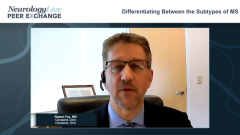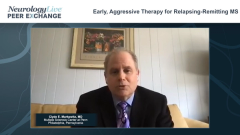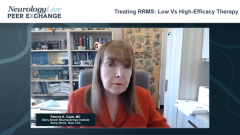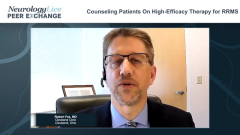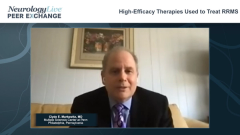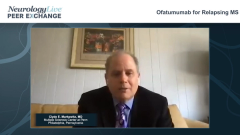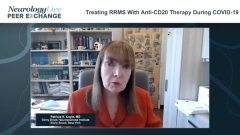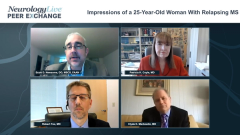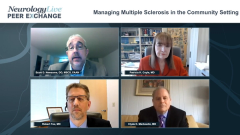
Impressions of a 35-Year-Old Man With Relapsing MS
Impressions of exam results and the prognosis for a 35-year-old man who presents with progressive numbness and weakness in his left arm and leg.
Episodes in this series

Scott D. Newsome, DO, MSCS, FAAN: Why don’t we move into a couple of cases? These are real cases: They are people I have seen in the clinic, and we can probably talk a bit about which therapeutic classes someone would use.
Let’s go on to the first case: a 35-year-old African American man presents with several weeks of progressive numbness and weakness on the left side. But about a year prior to his presentation, he experienced right arm and hand weakness. It lasted for a few months in terms of the magnitude of it worsening, but he has some poor penmanship from that episode. On exam, you can see that he has some disability: Fine motor skills are impacted on the right ride, he has moderate reduction in vibration sensation at the toes, and he has some left-sided weakness in what we would call a central nervous system pattern. Even on walking, you can see that he has a mild spastic gait. On brain imaging, he has more than 10 T2 brain lesions, and he has a couple of spinal cord lesions, 1 of which is enhancing.
I bring this case because this is quite common in terms of what we see in our clinics. Pat, I will have you lead off this discussion. With this particular patient, what are some of the features, clinical and paraclinical, that make you concerned? Or maybe you are not concerned at all about this individual?
Patricia K. Coyle, MD: I am not brain dead, so I am concerned. This is a poster child for a patient with MS [multiple sclerosis] with warning lights and danger signals coming off. This is why we talk about prognostic factors: no single 1 is the be-all and end-all, but when they travel together, this is a real concern. He has onset in his mid-30s. Some people consider that older onset. He is African American, and he is male, and those are our 2 prognostic indicators that are of concern. He has had 2 clinical attacks within a year. That is a fair pace. He made an incomplete recovery from his first attack, which is greatly concerning. You are talking about how 96% of patients recover from the first attack. If you do not, then that is bad. He has motor features, and it sounds as if he has some incoordination features as well. He has a high brain lesion load. You used 9 as a cutoff, and we have identified spinal cord lesions and infratentorial lesions as bad signs. He has a lot of bad prognostic indicators and evidence of active disease. This is somebody for whom, when I sat down saying how important it was for us to treat him, I would really be looking at a high-efficacy agent.
Scott D. Newsome, DO, MSCS, FAAN: Bob, what other features would you consider as aggressive onset, if we can use that term, or highly active MS, beyond what Pat has already mentioned?
Robert Fox, MD: Pat hit the high points. For me, the biggest high points would be the recurrent spinal cord involvement and the incomplete recovery. Those 2 things are the biggest elephants in the room for a patient whose MS has a predilection for the spinal cord and they already have incomplete recovery from his first spinal cord involvement. That has me very worried about this gentleman.
Scott D. Newsome, DO, MSCS, FAAN: Same here. It’s interesting. These days, we have been talking about vaccine hesitancy, and there is DMT [disease-modifying therapy] hesitancy, specifically in the high-efficacy class of agents as it relates to the pandemic, at least in my clinic [at Johns Hopkins Multiple Sclerosis and Transverse Myelitis Center]. When you see someone like this, you are concerned that he is not going to do well. Clyde, even though we would probably treat this individual similarly, is this a typical patient that would be a candidate for high-efficacy therapy?
Clyde E. Markowitz, MD: No problem: high-efficacy therapy.
Scott D. Newsome, DO, MSCS, FAAN: Would anyone do low-efficacy therapy?
Clyde E. Markowitz, MD: Pat said that she’s not brain-dead. I don’t think there’s a person in the MS field who would look at this case and say, “He would be fine for low-efficacy treatment.” No chance. There’s just no chance in that conversation.
You asked about whether there are other factors that we could be considering. You have enough in this case; you do not need anything else. But let’s say that this was not the case. This is a case for which spinal fluid testing could be useful, not diagnostically but potentially prognostically, where the patient may have a higher number of bands in the spinal fluid: IgM bands, etc. These are things we’re going to look at in the research arena, along with things like neurofilament light chains and things that might be able to help us predict what the outcome for somebody like this is going to look like in 5 or 10 years. That is an important piece. We don’t think of it that way. Spinal fluid has been used primarily for diagnostic purposes. But maybe in the future we’ll go back to this idea that there could be prognostic features in this. Not in this case, because this case fits every checkpoint you could think about. I would never even consider a low-efficacy therapy.
We deal with the same patient population that you do in Philadelphia [at the Multiple Sclerosis Center at Penn] where you have a lot of people who are concerned about hesitancy to getting on drugs during the pandemic and everything like that. Sometimes I have to spend 45 minutes trying to debunk the world that they have come into with the idea that they don’t want to be on a drug that’s going to cause PML [progressive multifocal leukoencephalopathy], or they don’t want to be on a drug that’s going to cause X, Y, and Z. You have to push this conversation because we know the outcomes; the patients do not. That’s my biggest concern: They do not know what we know. It is our job to communicate to them why this is so important for somebody like this. Because they may just say, “My friend is on an injectable therapy, and they seem to be doing fine.” No. This is a bad prognosis.
Scott D. Newsome, DO, MSCS, FAAN: Thank you for watching this Neurology Live® Peer Exchange. If you enjoyed the content, and I hope you did, please subscribe to our e-newsletters to receive upcoming Peer Exchanges and other great content right in your in-box.
Transcript Edited for Clarity
Newsletter
Keep your finger on the pulse of neurology—subscribe to NeurologyLive for expert interviews, new data, and breakthrough treatment updates.


